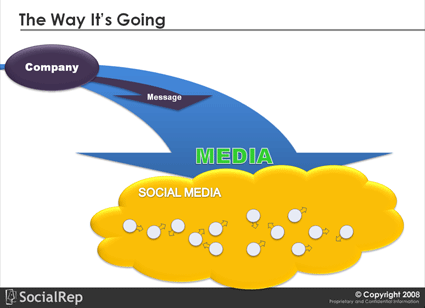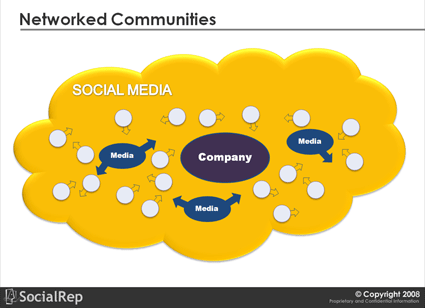 I‘ve been reading a bunch of the predictions for Social Media in 2009, including the Top Marketing Geek predictions at ReadWriteWeb. While the predictions are interesting, I find myself asking how we can know where we’re headed if we don’t take adequate stock of where are now? What’s driving social media today, and how does that help us better understand the direction we’re headed? I see five meta trends that are worth noting:
I‘ve been reading a bunch of the predictions for Social Media in 2009, including the Top Marketing Geek predictions at ReadWriteWeb. While the predictions are interesting, I find myself asking how we can know where we’re headed if we don’t take adequate stock of where are now? What’s driving social media today, and how does that help us better understand the direction we’re headed? I see five meta trends that are worth noting:
1. The Growth Curve: Size Does Matter
One of the biggest drivers behind behavior on social networks today is the imperative to generate quantity of connections over and above quality of relationships. Many people are focusing on activities that help drive up friends and followers, and while there’s some hand wringing among pundits about this emphasis on size over quality, I think we’re just seeing an important early stage of the social media phenomenon in which growth is critical to unlock the value of the network. There are real social and systemic drivers behind this growth-oriented behavior.
From a social standpoint, perception matters, and size is one of the easiest metrics for judging social standing. How many connections on LinkedIn do you need to be taken seriously as a job candidate? How many followers on Twitter do you need to be considered cool or influential? These are compelling social imperatives, however shallow we may think they are.
Now it’s true that the number of followers or friends is not a direct indication of the quality or influence of your network. But solely emphasizing quality of relationships ignores a simple systemic truth: there is a critical mass you have to reach before your network provides value, through shared insights, connections and opportunities. It’s some variation on Metcalfe’s Law—which says the value of a communications network is proportional to the square of the number of connected users to the system.
In order to build a high quality personal network, you have to have both size and quality. And it turns out it’s more efficient to generate volume, and then prune and tune your friends and followers when you see how individuals add value to your network. And in fact, this strategy is exemplified by gurus who worry more about quality than quantity when they talk about pruning back their friends and followers—they are operating from the luxury of a surplus that most users don’t yet have.
What does this mean for 2009? We’ll continue to see a proliferation of internet and affiliate marketing techniques focused on building social network volume. I’m often critical of these techniques, precisely because they run counter to the social media ideal of building relationships. But I believe these strategies are surging because they fit the evolutionary requirement of growing a network to unleash its value.
2. Data Overload: Managing Fragmentation
I don’t know about you, but I kind of breathed a sigh of relief when Pownce went dark. There are too many places to maintain a profile, and not enough ways to simplify the connections and bridge the gap. Why can’t I easily connect the groups I’m subscribed to on LinkedIn with Twitter so I can follow members of the group? Why can’t I merge my business blog with my Facebook business group? There are hundreds of little stumbling blocks that force us to be endlessly running around making updates and changes everywhere at once. Of the five metatrends I’m following, this easily the most obvious, and I think ReadWriteWeb summed it up better than I can in their own predictions for 2009. So I won’t belabor this one except to say that like others have predicted, I think we’ll see fewer new social networks launch next year, and a lot more tools to help manage the organization, convergence and optimization of data across distributed platforms.
3. Personal Branding: A Collective Identity Crisis
In my scanning of social media and marketing conversations for SocialRep, I’ve been amazed at the number of blog posts dedicated to personal branding. It’s not a new concept. But as emerging technology disrupts and transforms our social constructs, redefining our sense of self takes on new immediacy. We have old friends finding us on Classmates and Facebook. We have colleagues, co-workers, family and friends viewing the same profiles. We have potentially hundreds of new friends and employers who may be attracted or repelled by things we say online, and thanks to Google, it’s now a permanent record. Where we used to be able segment and contain our various selves, our identities are simultaneously converging in scope while expanding in reach, causing a collective sense of identity crisis.
How do we understand and define our role in an entirely new sense of community. Many of us just charge right ahead and go for broke, but look around and you’ll find many, many people avoiding the change social media represents. This is a big deal—far more substantial than the mid-90s Internet-driven turbulence that gave rise to the Change Management movement.
I suspect we’ll see the interest in personal branding grow into something more substantial and focused in 2009, leveraging all the uncertainty and disruption, possibly even the seeds of a new EST, or a new technology like Neuro-Linguistic Programming designed for online communication. Social media is already giving rise to its first, nascent cults of personality, but they’re only prototypes now, figuring out the mechanisms of growth and influence. I think we may see in 2009 a new Erik Erikson, or a new Carl Jung—someone who combines the reach of Scoble with a new and magnetic song of self, born and bred on the social graph.
4. Self-Help 2.0
This is closely related to personal branding, but sharply distinct. Where personal branding is about understanding our new sense of self in a transformed social world, self-help promises specific techniques and behaviors that maximize our personal potential, and almost always, our wealth. I haven’t yet seen a cohesive program for Self-Help 2.0, but the concepts are everywhere, merging social media how-tos, with tips for building and monetizing networks, and of course, relentless affirmation. It’s the fuel that, perhaps unwittingly, drives many of the most popular social media pundits, even though it isn’t labeled and articulated as such. It’s a unique new generation of self help designed for the socially wired. You can almost see the bridge between the last generation, Getting Things Done concept of behavioral techniques for productivity, and the new, 4-Hour Work Week model, that leverages the social Web to merge personal objectives with internet business strategies. Think Gary Veynerchuk. Or Godin’s Tribes.
Like the emergence of personality gurus, I think we’ll see new programs and techniques that define specific behaviors for online success in an increasingly uncertain world. Self-help is a massive economy in its own right, and I’m betting that somewhere, right now, someone is writing the Self-Help 2.0 best-seller of 2009. Count on it.
5. Hope. The New Online Destination
I’m not going to mince words on this one. Our economy is screwed. You need a PhD in economics to see the tidal wave cresting over our heads, but when you can’t turn on the news without hearing another economist running for cover, you know it’s not good. Amid this biblical meltdown, where it’s increasingly hard to feel optimistic, much less to escape the grind and refresh your perspective, social engagement can easily be the brightest spot in the day. An easy online connection brings never-ending access to new friends, new ideas and real opportunities. At any moment, you may find a long lost friend, or find the solution to a business problem that accelerates your career. And if you spend any time on social networks today, you know this isn’t hyperbole.
It’s no stretch to predict that social media adoption will accelerate in 2009, but I think the growth will drive new tools and technologies to more easily connect and build networks that deal with the challenges in the real world, from organizing charities to building new business networks and even new businesses. This is, of course, already happening in various places on the web, but the critical mass of people clamoring for new tools to connect and organize is already outstripping what Twitter, Facebook and LinkedIn can, or are willing to deliver. I’m not savvy enough to see how this will play out, but I suspect we’ll see new initiatives to organize free agents and open source developers, and new interest in leveraging online networks to address offline challenges. I think we’ll see a surge in Web-driven meetups, especially those that address or reflect economic fallout, like career networking, or local seminars and workgroups replacing national conventions. But most of all, I think we’ll start to see the opportunity and optimism that flows from online social connections drive new credence for social media in the mainstream, beginning to displace some of the derision social media has faced in 2008.
What do you think? What drivers do you see shaping social media trends in 2009?
Photo credit: Luckee Dogg










